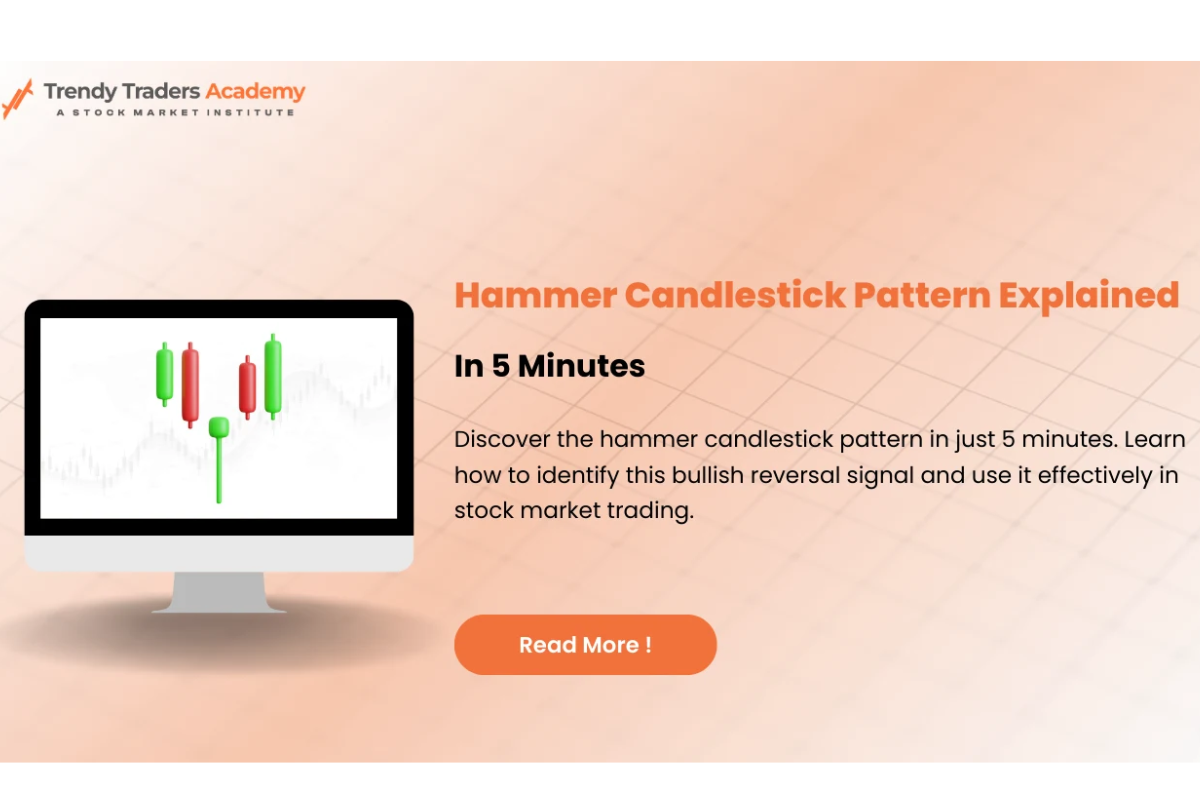
Hammer Candlestick Pattern Explained Simply
- quanttrix quanttrix
- Education
- 2025-08-22
- 595K
Hammer Candlestick Pattern: A Complete Guide for Beginners
Introduction
Imagine you are trying to read a story, but instead of words, the plot is told through lines and candles on a chart. Sounds intriguing, right? This is exactly how traders read the stock market. Among these "chart stories," the hammer candlestick pattern and the inverted hammer candlestick pattern are like the plot twists that warn us something big might happen.
These candlesticks are powerful signals used by traders worldwide to predict potential price reversals. And the best part? You don’t need to be a Wall Street professional to understand them. In this article, we will explore everything about these candlestick patterns in simple, easy-to-digest language — making it a perfect read if you’re just starting your stock market journey or exploring stock market courses.
So, let’s dive in and discover why a tiny "hammer-shaped" candle can actually drive big trading decisions.
Learn what the hammer candlestick pattern and inverted hammer candlestick pattern mean in trading. Explore examples, and stock market courses for beginners.
What is a Candlestick Pattern?
Before we dig into the hammer, let’s cover the basics. A candlestick pattern is a way of visually representing the price movement of a stock, currency, or commodity in a given time frame. Each candle tells a short story about the market:
- Where the price started (open)
- Where it ended (close)
- Its highest point during the session (high)
- Its lowest point during the session (low)
Think of each candle as a small diary entry from the market, recording what happened during that time.
Introduction to the Hammer Candlestick Pattern
The hammer candlestick pattern is shaped — you guessed it — like a hammer. It usually has a small body (the rectangle in the middle) and a long lower shadow (the stick). This ‘hammer’ shape shows that even if sellers tried to push prices down hard, buyers fought back and managed to close near the opening price.
It’s like when you push a basketball under water; no matter how hard you try, it bounces back up. Similarly, the hammer signals potential strength in buyers.
Characteristics of a Hammer
Here are the key features of a hammer candlestick:
- Small real body: Near the upper part of the candle.
- Long lower shadow: At least twice the size of the body.
- Little to no upper shadow.
- Often appears after a downtrend.
When you see a hammer at the end of a bearish trend, it usually means the downtrend might be losing steam.
Real-life Examples of Hammer Patterns
Imagine a stock has been falling for weeks. Traders are nervous, and selling pressure is high. Suddenly, one trading day, the stock drops sharply but then recovers and closes near the opening price. On the chart, this forms a hammer — signaling that buyers are stepping back.
Real-world hammer candlestick patterns are often spotted in major market turning points. For example, many stocks showed these signs after big economic announcements, where fear gave way to renewed buying confidence.
What Does a Hammer Signal in Trading?
Simply put: A hammer tells traders, “The bulls are back.”
If you’re a beginner, think of a hammer pattern like a road sign on a highway. Just as a “slippery road ahead” sign makes you cautious, a hammer makes traders alert to a possible reversal. However, it isn’t a guaranteed “buy now” sign — confirmation with the next candles is always advised.
The Inverted Hammer Candlestick Pattern
Now comes the cousin of our hammer — the inverted hammer candlestick pattern.
This one looks like an upside-down hammer, with a long upper shadow and a small body near the bottom. It appears after a downtrend and suggests that buyers tried pushing prices higher. Although sellers pushed them down again, the attempt hints at a possible reversal.
Think of it like a boxing match where one fighter (buyers) throws a surprise uppercut. Even if it doesn’t win the round, it signals potential comeback energy.
Key Differences Between Hammer and Inverted Hammer
| Feature | Hammer | Inverted Hammer |
| Shape | Long lower shadow | Long upper shadow |
| Placement | After a downtrend | Also after a downtrend |
| Significance | Buyers stepping in strongly | Buyers attempting to take control |
| Reliability | Higher | Moderate (needs confirmation) |
Importance of Context: Support, Resistance & Trend
Candlestick patterns alone are not magic. Their reliability increases when combined with support and resistance levels:
- Hammer at support zone → Strong reversal chance.
- Inverted hammer after a long downtrend → Potential reversal but needs bullish confirmation.
This is why stock market professionals emphasize context while teaching candlestick analysis.
How to Use Hammer Patterns for Trading
Here’s a step-by-step approach:
- Identify downtrend: Look for a series of falling candles.
- Spot the hammer or inverted hammer.
- Wait for confirmation: A green bullish candle following the hammer adds confidence.
- Set stop-loss: Below the hammer’s low (for risk management).
- Enter trade cautiously.
Common Mistakes Beginners Make
- Believing every hammer guarantees a reversal.
- Ignoring market trends and context.
- Entering trades without confirmation from the next candles.
- Forgetting to use stop-loss.
Effective Strategies with Hammer Patterns
- Pair a hammer with volume analysis: High trading volume means stronger signal.
- Combine with moving averages for trend confirmation.
- Use in tandem with RSI (Relative Strength Index) to check oversold conditions.
Combining Hammer with Other Indicators
Like seasoning in cooking, combining hammer candlesticks with other tools makes your trading tastier:
- MACD → Adds momentum confirmation.
- Support zones → Boosts reliability.
- Trendlines → Highlight overall direction.
Why Stock Market Courses Teach Hammer Patterns
Almost every stock market course covers candlestick analysis early on because it’s fundamental and easy to understand. Recognizing a hammer or inverted hammer gives beginners a strong first step into technical analysis.
These courses often include live chart practices, making it easier for students to confidently spot and use these patterns in real trades.
Real-World Stories & Case Studies
One famous case was during the 2020 global market crash. Many stocks showed hammer candlestick patterns during March lows, signaling bottoms. Those who spotted and acted wisely enjoyed huge profits during the rebound.
This shows that while technical patterns can’t predict everything, they can give traders powerful clues when used correctly.
Conclusion
The hammer candlestick pattern and the inverted hammer candlestick pattern are like market whispers hinting at a possible change. While not foolproof, they are essential tools for anyone learning technical analysis. Remember — context, confirmation, and caution are your best friends in trading.
If you’re serious about learning, consider enrolling in stock market courses to practice these concepts hands-on. Because in trading, knowledge truly is power.
FAQs
1. What does a hammer candlestick pattern indicate?
It signals a potential reversal after a downtrend, suggesting that buyers are regaining control.
2. Is the inverted hammer candlestick pattern reliable?
Yes, but it requires confirmation from the next bullish candle as it’s weaker than the hammer.
3. Can hammer patterns appear in any time frame?
Yes, they can form on daily, weekly, or even intraday charts. However, longer time frames (daily/weekly) are more reliable.
4. Do I need stock market courses to learn candlesticks?
While self-learning is possible, structured stock market courses provide guidance, practical examples, and expert insights.
5. Is trading only based on hammer patterns advisable?
No, it’s best to combine them with indicators like RSI, MACD, and volume for higher accuracy.










